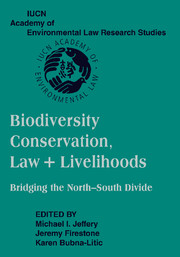 Biodiversity Conservation, Law and Livelihoods: Bridging the North-South Divide
Biodiversity Conservation, Law and Livelihoods: Bridging the North-South Divide Published online by Cambridge University Press: 31 July 2009
INTRODUCTION
When I last spoke on Monday during the opening ceremony, I talked briefly about the many magnificent national parks we have so close to Sydney. While I'm particularly proud of those parks, today I want to talk about what's been happening in the rest of New South Wales. I especially want to focus on one part of the State, as it provides an excellent and very contemporary example of our experience in implementing biodiversity conservation.
First, let me place my remarks incontext.
The current NSW government, under the leadership of Premier Bob Carr, was first elected in 1995. It was reelected in 1999 – at which time I became the Minister for the Environment with responsibility for national parks and biodiversity conservation – and again in 2003. Over that time, there has been a significant expansion of the conservation reserve system in New South Wales (NSW).
For example:
In 1995, there were 4 million hectares of national parks in NSW. There's now nearly 6.5 million hectares. That's almost 8 percent of the State's land mass, a 63 percent increase;
In 1995, there were no marine parks in NSW whatsoever. There's now four, covering more than 160,000 hectares of our coastal waters;
Since 1995, the area of wilderness in NSW – the very highest conservation reserve category – has more than tripled;
We now have more than 1.7 million hectares of private land included in what are known as Wildlife Refuges or Voluntary Conservation Agreements. This land is owned by conservation-minded citizens and is managed and protected accordingly.
To save this book to your Kindle, first ensure [email protected] is added to your Approved Personal Document E-mail List under your Personal Document Settings on the Manage Your Content and Devices page of your Amazon account. Then enter the ‘name’ part of your Kindle email address below. Find out more about saving to your Kindle.
Note you can select to save to either the @free.kindle.com or @kindle.com variations. ‘@free.kindle.com’ emails are free but can only be saved to your device when it is connected to wi-fi. ‘@kindle.com’ emails can be delivered even when you are not connected to wi-fi, but note that service fees apply.
Find out more about the Kindle Personal Document Service.
To save content items to your account, please confirm that you agree to abide by our usage policies. If this is the first time you use this feature, you will be asked to authorise Cambridge Core to connect with your account. Find out more about saving content to Dropbox.
To save content items to your account, please confirm that you agree to abide by our usage policies. If this is the first time you use this feature, you will be asked to authorise Cambridge Core to connect with your account. Find out more about saving content to Google Drive.